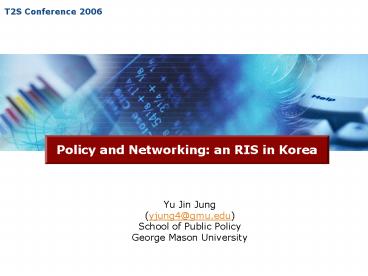Policy and Networking: an RIS in Korea - PowerPoint PPT Presentation
1 / 17
Title:
Policy and Networking: an RIS in Korea
Description:
Purposes of the study: Analyzing the relationship between policies and the ... Can we call the Daedeok Science Park (before July 2005) as an RIS case? If we ... – PowerPoint PPT presentation
Number of Views:54
Avg rating:3.0/5.0
Title: Policy and Networking: an RIS in Korea
1
Policy and Networking an RIS in Korea
- Yu Jin Jung
- (yjung4_at_gmu.edu)
- School of Public Policy
- George Mason University
2
Overview
1. Introduction
2. Definition RIS
3. Korean RIS the DSP
4. Policies from 1998 to 2002
5. Networking Pattern Analysis
6. From the DSP to the DI
7. Conclusion
3
Introduction
- Purposes of the study Analyzing the relationship
between policies and the regional networking
patterns - Can we call the Daedeok Science Park (before July
2005) as an RIS case? If we can, what type of RIS
is it? - What were the governmental policies affecting
public research institutes in the era of DSP
(from 1998 to 2002)? - During the DSP era, were all networking patterns
between businesses and research institutes the
same or not?
4
Definition RIS
- Regional Innovation System (RIS)
- Innovation system explains innovation processes
through the interaction between institutional and
organizational elements (systematic perspective). - Concept of RIS was started from NIS.
- An RIS consists of interacting knowledge
generation and exploitation sub-systems linked to
global, national and other regional systems for
commercializing new knowledge (Cooke and others,
2004). - Two kinds of subsystems production system and
institutional system
5
Definition RIS (continued)
- An RIS is
Research Institutes
Another RIS
Another RIS
Universities
Firms
Innovation
Governments Others
6
Korean RIS the DSP
- Daedeok Science Park (DSP)
- In 1970s, the DSP was built by the central
government in Daejeon as the first region for
balanced national development and regional
economy development as well as RD, human
resources and information interchange, and
cooperation research within the country. - However, because of changed government strategy
focusing on NIS or RIS, the DSP had changed from
the research park to the RIS with newly emerging
high-tech firms.
7
Within the DSP
Formation of networking Among actors and infra
8
Policies for the PRIs (1998-2002)
- Governmental Policies affecting the Public
Research Institutes in the DSP from 1998 to 2002 - Almost all RD projects were assigned, funded,
and managed by the National RD Initiative. - Products, results, and technologies are patented
and commercialized through the follow-up research
or the cooperative efforts with private sector. - Some PRIs earned profits from their business
support services (e.g. technology assessment,
chemical analysis, and reliability evaluation)
9
Networking Pattern Analysis(1998-2002)
- Methodology
- Comparison Between the ETRI and the KRICT
- Electronics Telecommunications Research
Institute (ETRI) and the telecommunication
companies in the DSP - Korea Research Institute of Chemical Technology
(KRICT) and the chemical companies in the DSP - Log function comparison in spin-off, information
/ equipments provision, technology guidance and
consultation, loyalty contracts, loyalty
contracts (amounts), technology transfer, and
financing - Based on the annual performance reports of the
two institutes - Interview Results with the researchers in the two
PRIs
10
Networking Pattern Analysis(1998-2002)
- Comparison
- ETRI vs. KRICT (in the telecommunication industry
and in the chemical industry)
ltETRIs networkgt
ltKRICTs networkgt
11
Networking Pattern Analysis(1998-2002)
- Findings (1)
- Both PRIs patterns are similar annually.
- Each institutes networking
- ETRI
- overall statistics were growing
- shows balanced networking methods
- KRICT
- overall statistics were growing (but not clear)
- more focused on facilities and equipments
provision (shows limited networking patterns)
12
Networking Pattern Analysis(1998-2002)
- Findings (2)
- Networking patterns are closely related to the
characteristics of the industries. - Telecommunication industry
- market-oriented (short-term production cycle),
small-size tech units, and very sensitive to the
national economy - Chemical industry
- KRICT is mainly providing public services to SMEs
(for the public purposes) - dangerous and needed longer time to be
commercialized (long-term production cycle)
13
From the DSP to the DI (since July 2005)
- In the era of the DI
- Daedeok RD Special Zone Law (Nov. 2004)
- Declaration of the Daedeok Innopolis (Jul. 2005)
- Based on the law, the DI has received full
support from all levels of the government. - Paradigm shift
- All regulations and institutions affecting the
DSP have been changed - Master Plan for the DI four purposes, twelve
action plans
14
In the DI Master Plan
15
Conclusion
- Impacts of governmental supports to the two PRIs
technology innovation were presented. - Even in the same RIS, individual actor shows
different networking patterns based on each
industrys characteristics. - To promote innovation and active networking, the
government should consider industrial attributes.
16
In the Future
- Follow-up studies are required.
- i.e. the implementation of DI plan and its
impacts on the same PRIs - Diversified research about the relationship
between PRIs and firms in all industries should
be done.
17
Thank You
- Questions?































